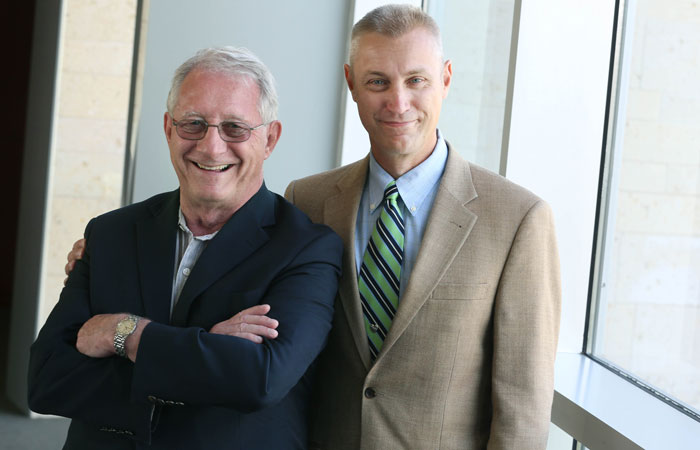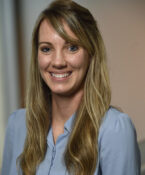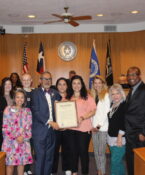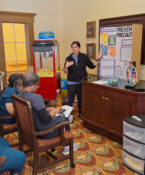For astronaut, UNTHSC was where it all began

By Alex Branch
Scientists who studied at UNT Health Science Center have taken their skills to all parts of the world. Jim Pawelczyk, PhD, took his into space.
Almost 20 years ago, he boarded space shuttle Columbia as a payload specialist on a 16-day flight devoted to the study of the brain and central nervous system. He took with him a University of North Texas banner and 2,000 rats, mice, fish, crickets and snails to study how the absence of gravity affected the creatures.
“A modern-day Noah’s Ark,” NBC News dubbed the 1998 shuttle flight.
“From a professional standpoint it was like working at your desk for 2 ½ weeks without ever leaving,” Dr. Pawelczyk said. “From a personal standpoint, floating over to the window and looking down on earth is just as spectacular as you imagine it.”
By the time Columbia landed at Kennedy Space Center on May 3, 1998, Dr. Pawelczyk and six crewmates had traveled 6.4 million miles, orbited earth 256 times and conducted 26 primary scientific experiments on themselves and their cargo.
Their innovative research advanced the scientific understanding of how the brain and central nervous adapt to changes in gravity, discoveries that could be applied to help people living with Alzheimer’s disease or recovering from strokes.
Many of the skills that led NASA to choose him for the mission were honed at the Health Science Center.
“It’s really the place where it all began,” he said.
The right skills
Dr. Pawelczyk’s path to the Health Science Center began in the mid-1980s at a professional conference when he introduced himself to Peter Raven, PhD, a former Health Science Center professor and internationally renowned leader in the field of cardiovascular regulation.
“By the time we finished talking, we had figured out my research dissertation,” Dr. Pawelczyk recalled. “Dr. Raven is a great experimentalist who always seeks practical application of his research. That combination is somewhat rare.”
From 1986 to 1989, Dr. Pawelczyk worked closely on the Fort Worth campus with Dr. Raven and other scientists, including Michael L. Smith, PhD, Professor, Institute for Cardiovascular and Metabolic Disease.
Like many kids who grew up in the 1960s, Dr. Pawelczyk dreamed of space travel. As a researcher, much of his work applied to the study of space sciences.
So when NASA announced plans for the 1998 Columbia flight, he joined a research team at the University of Texas Southwestern Medical Center that was selected to help define the mission. Dr. Pawelczyk was nominated to apply to participate as one of two researchers on the flight.
“I had the right skills, at the right time, for this particular mission,” he said.
Before he started NASA astronaut training, FBI agents came to the Health Science Center to interview his colleagues as part of a background check.
“They asked me if I was aware of Jim having any plans to overthrow our government,” Dr. Smith said. “Fortunately, I managed to keep my laughter inside.”
The mission
Space shuttle mission STS-90, also known as Neurolab, launched on April 19, 1998. Dr. Pawelczyk, one of seven crew members, spent up to 14 hours a day in the Space Lab, a school-bus sized laboratory in the shuttle’s cargo bay.
One experiment examined how rat brains process and adapt while maneuvering through a three-dimensional track in zero gravity. Another investigated the formation of gravity sensors in crickets and snails that are similar to the structure of the inner human ear.
The astronauts themselves were tested to learn about how space travel affects humans. Immediately after space travel, two-thirds of astronauts cannot stand upright for 10 minutes without passing out. Pawelczyk inserted microelectrodes into nerves in his crewmates’ legs to measure how their nervous systems controlled blood vessels that feed skeletal muscle.
Other experiments required the astronauts to play a simple game of catch to study how humans account for the absence of gravity. If someone throws a ball to you in normal gravity conditions, the ball will rise and then fall as it approaches you, decelerating and accelerating along the way. Your brain accounts for the fact that gravity affects the velocity of the ball as you prepare to catch it.
“How do we do that? We don’t calculate the equations in our head,” Dr. Pawelczyk said. “We are encoded with that ability. So the question becomes, ‘How is this information encoded?’”
Why are those answers important? Because people who suffer strokes or develop Alzheimer’s disease lose those encoded abilities.
“One day research could help develop more effective ways to help patients regain or maintain those abilities,” he said.
16 days in space
In space, astronauts are trained to expect the unexpected. That’s why they spend two full years preparing for everything that could go wrong.
The shuttle’s carbon dioxide scrubber – a device that removes carbon dioxide from the shuttle’s air so it is safe to breathe – broke on Dr. Pawelczyk’s flight. The crew worked with mission control to bypass the broken scrubber. The mission otherwise encountered few problems.
That doesn’t mean Dr. Pawelczyk’s family didn’t worry. His wife and two children, then ages 4 and 7, awaited his return at the family’s home in Indiana. His flight came 12 years after Space Shuttle Challenger broke up after takeoff and five years before Space Shuttle Columbia – the same aircraft in which Dr. Pawelczyk flew – disintegrated in midair over Texas.
“I’d talk to my kids from the shuttle by radio conference and they’d want to know why I couldn’t just come home now,” he said. “They didn’t quite understand how far away I was.
Sharing a small space with six other astronauts for 16 days requires creativity. During meals or when they slept, some of the crew members would sit on the ceiling or tether their sleeping bags to the ceiling to create more space for people on the floor.
Even that scenario presented intriguing questions to the scientists on board, he said.
“If I‘m on the ceiling looking down at someone on the floor and he’s looking up at me, then we both appear upside down to each other,” Dr. Pawelczyk said. “Who is right?”
Thrilling innovations
Dr. Pawelczyk remains deeply involved in space life sciences. He serves on multiple NASA advisory boards and testifies before Congress on science in space, most recently advocating for increased research capabilities on the International Space Station.
The space shuttle program, however, is no more. The final flight occurred in 2011, the last of 135 missions that forever pushed the boundaries of technology and space exploration.
“The space shuttle was perfectly suited for its job,” Dr. Pawelczyk said. “But I think of it like a great car that you’ve had for 20 years – it served you well, but at some point it’s time to trade it in. As we move beyond low earth orbit to planetary exploration, we need new spacecraft.”
The latest space flight innovations are thrilling, he said. Among the advancements are NASA’s Orion Spacecraft and private projects like the SpaceX Dragon, Orbital Sciences Cygnus and Dream Chaser.
The sense of wonder and possibility that outer space evoked in Dr. Pawelczyk first as a child and then at the Health Science Center, is as powerful as ever.
“I am as excited as ever about space travel,” he said. “I can’t wait to see what we do next.”





Social media